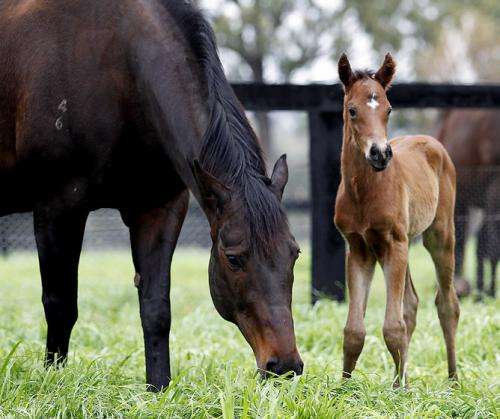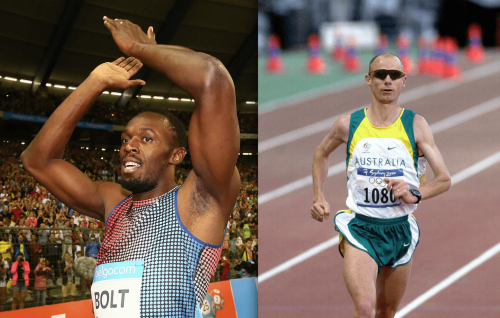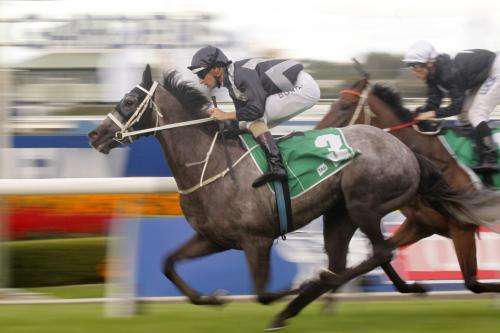How to hit the genetic jackpot and breed a Melbourne Cup winner

The win of Japanese stayer Admire Rakti in the Caulfield Cup, followed by Irish bred colt Adelaide's win in the Cox Plate last Saturday, has brought into question the stamina (staying) credentials of Australian bred racehorses.
It seems less and less likely that an Australian bred horse will win another Melbourne Cup, and most people involved in horseracing will tell you that Australian horses are not bred to win over long distances.
So, what are they bred to do? And how does someone go about breeding a Melbourne Cup winner?
The major factors usually taken into consideration by breeders when planning matings are racing performance, pedigree and the conformation (size and shape) of the horse. The horses that have won the best races clearly had the right genetics to do so, and it is assumed they will pass these genes on to the next generation.
The body beautiful
"Breed the best to the best and hope for the best" is an old Thoroughbred breeding adage which is still often referred to today.
A horse's pedigree is traditionally considered to be of utmost importance. By assessing the performance of close relatives, breeders can get an idea of the likely genetic merit of their horse. This is particularly important when a horse does not race due to an accident or illness.
Pedigree analysis is also a strategy used to plan matings. There are many breeding theories (such as Dosage, the X-factor and Nicks) that identify matings that are most likely to produce a foal with the right combination of complimentary genes from their parents.
Good conformation is also significant. In Australia, much emphasis is placed on the horse being a reasonable size, with strong straight legs, clean joints and a good amount of muscle.

This build is indicative of a higher proportion of fast twitch muscle fibres, which are responsible for power and speed, particularly over shorter distances. Stayers, such as Melbourne Cup winners, tend to be the opposite build, and are often tall, long and lean. You can liken these to the differences in the build of the muscular sprinter Usain Bolt versus the exceptionally lean marathon runner Steve Moneghetti.
Impact of pedigree
But to what degree are any of these traits heritable? Does pedigree actually relate to racing ability?
Well, genetics only accounts for around 30% of racing performance, with the rest influenced by environmental factors such as nutrition, trainer, track surface and, of course, luck.
We have recently assessed the relative contribution of genetics to certain performance traits in Australian Thoroughbreds. We found that winning times tend not to be influenced by pedigree, while earnings are moderately influenced. The trait most influenced by pedigree is called "best race distance".
Best race distance is the distance at which a horse won its best (highest grade) race. In Australia, flat races are generally between 1,000m and 3,200m long. The world's richest race for two-year-olds, the Golden Slipper, is 1,200m, while the Melbourne Cup is 3,200m.
Australia's racing and breeding industry is generally aimed at producing elite sprinters that are at their best over the 1,200m of the Golden Slipper. Black Caviar won 18 of her 25 races at 1,200m.

Testing times
These days, you don't even have to wait until your horse has started its racing career to find out what its best race distance is likely to be.
Before the foal is even weaned, you can just pull out some mane hairs and send them to one of the Thoroughbred DNA testing laboratories for analysis. They can tell you whether your horse is likely to be a stayer or a sprinter, what height it will be and if it is likely to be an elite performer.
Discover the latest in science, tech, and space with over 100,000 subscribers who rely on Phys.org for daily insights. Sign up for our free newsletter and get updates on breakthroughs, innovations, and research that matter—daily or weekly.
These companies have analysed the DNA of elite racehorses and identified sections of DNA that are associated with performance traits. Emmeline Hill's Equinome was the first to relate the myostatin gene with best race distance. She showed that a "marker" in this gene was related not only to sprinting performance, but also to the amount of muscle a horse carried, resulting in a heavier, more powerful type of horse.
This marker is found at high frequency in the Australian racehorse population, indicating that Australian breeders have been unknowingly selectively breeding for this marker for many years by preferring strong powerful sprinting types of horse over lean staying types.
So is this the future of racehorse breeding? DNA testing is just one of many tools that breeders can apply in pursuit of that dream of producing an elite racehorse. Intangible skills such as evaluating a horse by eye will never be completely replaced by science.
Rags-to-riches tales such as the stories of Joe Janiak and Takeover Target, or Mick Burles and The Cleaner, will always be a part of Australian racing folklore, and there is no doubt our racing traditions are richer for them.
Source: The Conversation
This story is published courtesy of The Conversation (under Creative Commons-Attribution/No derivatives).
![]()

















